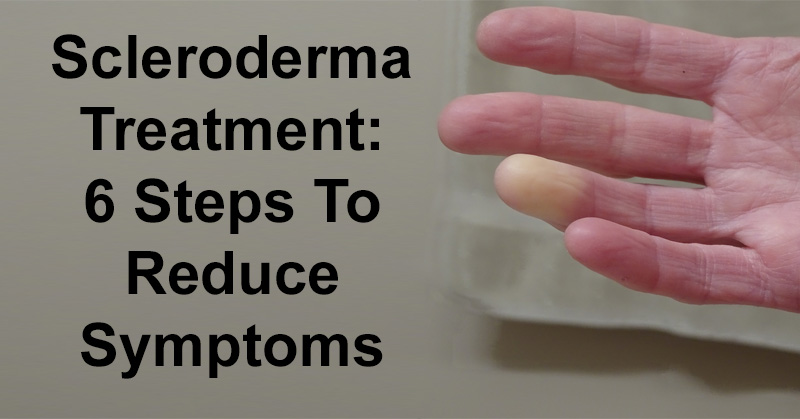Scleroderma is a group of rare diseases. It involves the hardening and tightening of the skin and connective tissues. For some, scleroderma only affects the skin. However, for some, scleroderma also harms blood vessels, internal organs and the digestive track Scleroderma symptoms vary, depending on what part of the body is affected. While there is no cure for this disease, a scleroderma treatment can help manage symptoms and improve quality of life. (1)
Consider these 6 steps to reduce scleroderma symptoms:
1. Physical Therapy
Scleroderma causes, or can cause, stiff and painful joints. Physical therapy can help prevent the loss of joint motion, which can occur when your skin becomes taut. For example, exercises to increase range of motion include stretching fingers, hands, wrists and shoulders. Furthermore, squeezing putty can help improve grip strength. (2)
Additionally, PT will help a patient with scleroderma to perform daily activities in such a way that it won’t put stress on their joints. And splints are used, as well, to prevent the loss of range of motion and contractures. This is when the muscles, tendons or tissues harden and result in deformed or rigid joints. (3)
2. Reduce Pain with Exercise

Scleroderma causes, quit often, pain that interferes with socializing, though the amount of pain can vary from patient to patient.
While an exercise program won’t work the same for everyone, it may be a beneficial scleroderma treatment method. Researchers shows that personalized exercise programs are most likely to support and encourage physical activity in patients with scleroderma. (4) Speak to your doctor before starting a new exercise regime.
3. Moisturize the Skin

As those who suffer from scleroderma symptoms often deal with dry skin, moisturizing can also be an effective scleroderma treatment. To cool inflamed skin, reduce itchiness and relieve pain all while adding much needed moisture to your skin, try a mixture of peppermint oil and coconut oil. Combine 1 to 2 drops of peppermint oil with half a teaspoon of coconut oil. Rub the mixture topically on the area in question. However, be sure to first test a small area to see how your skin will react to it.
Furthermore, you can protect your skin by avoiding harsh household products. Examples of this include laundry detergent and cleaners. You should also avoid extremely hot showers and being in the sun for too long. In extreme cold temps, a humidifier can help.
4. Remove Triggers and Eat Foods That Heal

Scleroderma causes, in some cases, malnutrition. In fact, malnutrition is common in about 30 percent of patients with scleroderma. Furthermore, in 5 to 10 patients, gastrointestinal disorders are the leading cause of death. Therefore, nutritional changes are needed as part of a scleroderma treatment plan. (5)
As scleroderma is an autoimmune disease, you should avoid food triggers that cause an immune response and inflammation. Examples of this include refined carbohydrates, artificial ingredients, spicy foods, alcohol and caffeine. You may consider an elimination diet to see which foods in particular are a problem for you.
While cutting out triggering foods, be sure to add healing foods to your diet.
Include such foods as:
- fresh vegetables, for example: asparagus, beets, broccoli, carrots, celery, cucumbers, leafy greens, mushrooms and squash
berries, such as blueberries, blackberries, goji berries, raspberries and strawberries - healthy fats, like avocados, coconut oil, coconut milk, grass-fed butter, olive oil and almond oil
- nuts and seeds, like almonds, pecans, pistachios, walnuts, chia seeds, flaxseeds, pumpkin seeds, nut butter and seed butter
- spices and herbs, such as basil, cilantro, cinnamon, cumin, garlic, ginger, oregano, rosemary and turmeric
5. Consume Probiotics
As they can help repair your gut and tissues, probiotics may help relieve scleroderma symptoms. In fact, research from the University of Utah dictates that probiotics significantly improves reflux and bloating in patients with scleroderma. (6)
You can take a probiotic supplement, or, preferably, consume probiotic foods. Examples of this include kefir, kombucha, cultured vegetables, apple cider vinegar and tempeh.
6. Seek Counseling or Support
Scleroderma patients commonly suffer from anxiety, depression, and body image issues. Studies show that peer support is effective, as it involves speaking to someone who is going through the same thing. Telephone and internet conversations are better attended as they are flexible and private. (7)
Cognitive behavior therapy and social skills training can also be helpful for those who suffer from scleroderma. These programs can help you deal with the physical changes you are experiencing. (8)


